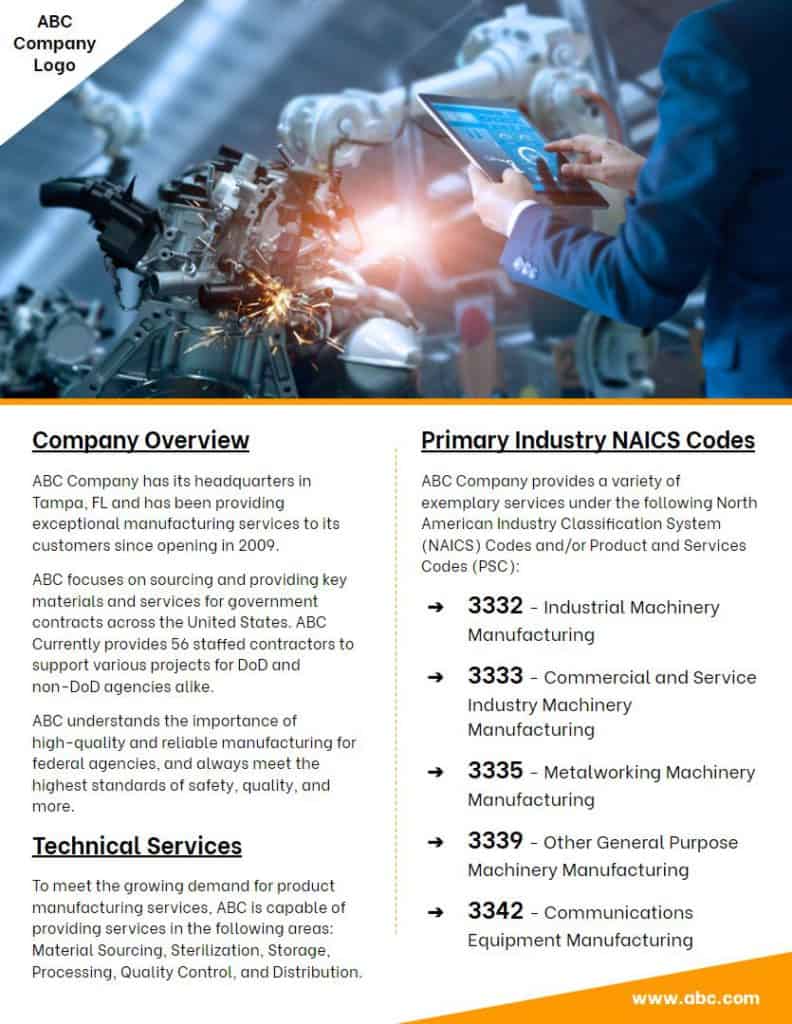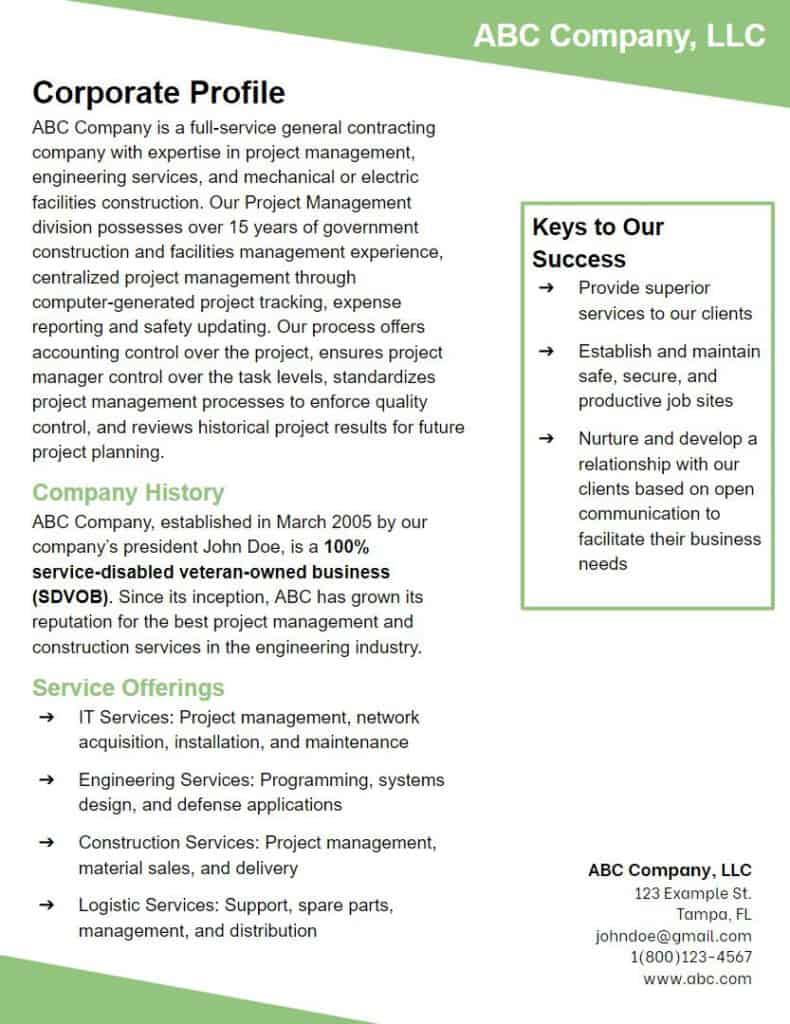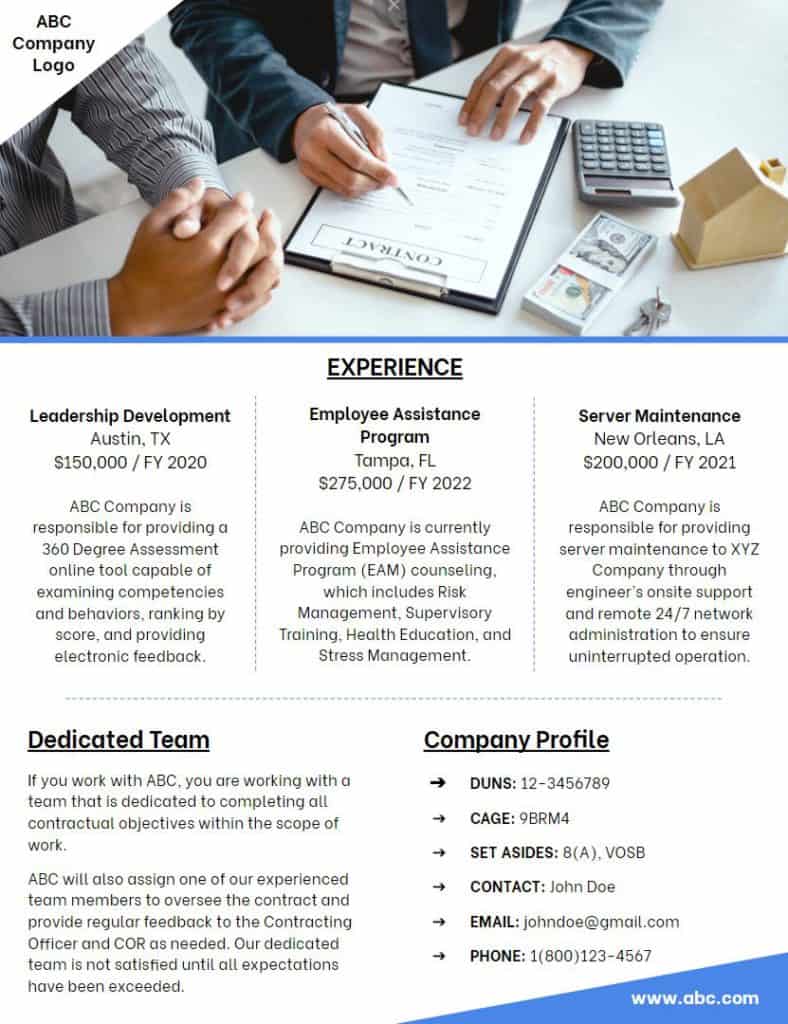Winning contracts from federal agencies can be an incredibly valuable tool for all types of businesses. Whether you’re a small business, a new business, or an established business, a capability statement lays the foundation of your bid for a job.
What is a Capability Statement?
The reason a capability statement lays the foundation is that it acts as a resume for your company. It’s a document that outlines why your organization is a good fit for a federal contract and what benefits you can provide the agency. It condenses your business down to a skimmable one or two-page summary of what your company does, why it does them well, and proof of previous experience. Capability statements help government agencies looking for qualified businesses for contracts to find ones that are good fits.
General vs. Targeted
When you’re creating a capability statement, there are two primary routes you can take. Similar to a resume for finding a job, you can create a “one size fits all” version that stays the same for every application you send it with. Or, you can create variations, or more targeted versions, that are tailored to a specific job or application.
Targeted capability statements are usually more effective, but also take much more time to craft and update. General capability statements are more efficient because they can be sent to anyone at any time, but will likely see less success than one that’s personalized to the specific opportunity or agency.
Why You Need a Capability Statement
First impressions are a huge deal, and when it comes to federal contracting, your first impression may be the only one you get. Capability statements are used to evaluate and weed out contract applicants, so having one that’s eye-catching and presents your company’s strengths can be the difference between winning and losing a contract. Creating a capability statement can also force you to nail down factors such as your core competencies and what makes your company unique, which can be helpful for other uses (like hiring and company culture).
How to Write Your Capability Statement
So you understand that you need a capability statement, but how do you get started? If you’re a small or new business, this can seem overwhelming and like you don’t have enough information to put one together. However, we broke down each step to make it as manageable as possible for you, no matter what size or stage your company is in:
- Design: While the content of your capability statement is the primary focus, the design can also have a significant impact. It can either be an opportunity to create an eye-catching and memorable design or one that’s forgettable or hard to read. A good rule of thumb is to use a highly-readable font with two colors at the most. Your logo and contact information somewhere at the top also makes the capability statement feel more professional.
- Introduction: Once you’ve picked a design and format you like, start with an introductory paragraph that describes your company and what goods or services you provide. Make sure not to ramble here, it’s important to be concise and to the point but still give a complete overview of the business.
- Basic Company Info: This part should be easy, as it’s simply the company information that will be used to identify and contact your business. Things such as website, point of contact at the company, their phone number and email, and the physical address of your business should be included, along with any other basic information you deem necessary.
- Corporate Data: This section will be similar to the previous section but compiles information specifically through your SAM registration and certifications. That includes your UEI number, CAGE code, SBA certifications (8a, HUBZone, GSA, etc.), NAICS codes, NIGP codes, PSCs, and any other certifications you might have.
- Core Competencies: Next up, the core competencies section expands on what your company does well. It gives you a chance to elaborate and showcase what you bring to the table for a contract or opportunity. This section is usually a bulleted list that gives agencies more information but is still skimmable.
- Past Performance: Here, you can present previous jobs or clients you’ve worked on to demonstrate your reliability and history of quality work. As with the previous section, it gives you a chance to build your authority and credibility to show federal agencies that your company is the best fit for the job. It can also act as a references section, but you don’t have to worry about including contact information for the entries.
- Differentiators: Often the most time-consuming component of capability statement writing, this is where you discuss what sets you apart from competitors. While the core competencies directly relate to what you provide, differentiators can be intangible assets such as experience, adaptability, relationships with suppliers, and more. Think about what makes your company stand out from others in the industry (and others who might be applying for the same opportunity) to create a comprehensive list of reasons the government agency should select your company.
Capability Statement Examples
Now that we have a frame for what capability statements should convey and highlight, it can be helpful to see examples. Whether for design, to better understand how information can be organized and conveyed, or for a number of other reasons, these sample capability statements should give a foundation for you to start your own:
Sample 1:

Sample 2:

Sample 3:

Get Expert Help
However, making your own from scratch can be complicated (and difficult if you’re not a graphic designer). Whether you still need to complete your SAM registration or are ready to create (or revamp) your capability statement, FAMR’s team of federal marketplace experts can help you through the process. Our FEDAdvantage program has a gallery of design options to choose from to find something that suits your business. Combined with our knowledge of what goes into a successful capability statement, we’ll help your company’s chances of winning valuable contracts and funding in the federal marketplace.

